Per-pupil school funding widens some equity gaps
Basic educational needs not guaranteed in current system

With the new Boston Public Schools budget making cuts at 49 schools, many are questioning whether the current per-pupil funding system actually improves equity.
Due to declining enrollment, many struggling schools are having their resources cut. In some cases, this is due to fewer parents choosing to select the schools when their levels drop, thus causing per-pupil funds to dwindle. But in other cases, the school continues to perform, yet receives a slashed budget.
The John W. McCormack Middle School is one example of a school losing students — and funding — due to a district policy change, not anything within its own control. The district redesigned its enrollment structures so that instead of five elementary schools feeding students into the McCormack Middle, only four do. Enrollment dropped and its next budget plunged by approximately $1 million, or about 21 percent. Neema Avashia, a grade 8 civics teacher at the McCormack, says that cuts are producing losses or continuing a failure of BPS to provide funding for programs teachers deem an essential part of a well-rounded education, as well as challenging efforts to make school a safe place for traumatized children.
BPS officials say the per-pupil budget system is not to blame for all of this: funding for facility changes to making the school less likely to trigger trauma responses and funding for staffing nurses are handled separately from the weighted student funding formula.
Officials also state that the district works with schools that are facing declining enrollment to develop a plan and budget for serving their students, and that the district provides $15 million in supports to Level 3, 4, and 5 schools.
McCormack’s losses
The problem with the weighted student funding system in its current form, Avashia says, is that when money is allocated largely based on enrollment, there is no safeguard to ensure that every school always will be able to afford a full-time nurse, library, guidance counselor and other basic educational needs.
“Just because you have fewer than 400 students doesn’t mean you don’t need a nurse full-time because [now] kids only get sick in the morning,” Avashia said. “There still are children here. Lots of children. And there are things they should have as part of their education, even if there are not as many children as last year.”
BPS officials, meanwhile, say weighted student funding system is not to blame for allegations of nurse shortages. Nurse staffing is separately budgeted and allocated by the district, which assigns a number of nurses to each school based on the school size and a determination of the acuity of student need at that school, officials say.
Still, Avashia says that under the budget cuts, staff members are struggling to maintain offerings that teachers regard as critical to education. Chorus and band classes will be dropped. BPS already does not provide the school with enough to afford a library; staff had to crowdfund to create one and will continue to rely on outside generosity and volunteers to maintain it.
While many middle schools offer social studies and science only every other day or only for half the year, teachers at McCormack believe year-round daily classes are a critical part of a well-rounded education. However, budget cuts translate to staffing cuts and will put more of a strain on this practice; instead of being taught by designated subject-specific teachers, science and social studies now will be taught by teachers who are spread between multiple subject and/or grades, Avashia said.
McCormack also relies on outside fundraising in order to offer a yearly trip to New York, something Avashia said often is an eye-opening experience that fosters middle school-aged children’s developing independence and expands their world knowledge. For many kids, it is their first time outside Boston or away from home without their parents. She notes that all these were options provided to her as a child in a rural, working-class community but without fundraising to supplement the city-provided budget, would be out of reach for children in wealthy Boston.
“I grew up in rural West Virginia, and in rural West Virginia, we had a school library [and]… a trip to D.C. every year. I’m not saying these are things you only get in an affluent suburban community,” Avashia said. “These are essential elements of the education of young people. This stuff isn’t optional. This is what education should be and we should be thinking of how we fund that.”
Children with trauma
Budget cuts throw barriers in the way of initiatives known to help traumatized children feel safe, Avashia said.
The school already relies on grants and volunteers to establish and maintain its library, including providing furniture, books and staffing. Beyond educational resources, the library also provides a safe space for children coping with trauma.
“Part of the impetus behind creating a library is to create a safe space that would help kids calm down and know they’re safe and welcomed, and where they could be connected and supported within the space,” Avashia said.
One item indefinitely stuck in the idea phase due to lack of funding: a cafeteria redesign intended to eliminate environmental trauma-triggers for a student body that was nearly 92 percent low-income in school year 2013-2014, according to BPS data.
Schools can be aggravating environments for traumatized children, who tend to be hyper attuned to their surroundings and on guard for threats, Avashia said. Classic institutional structures, in which sounds reverberate and fluorescent lighting intensify and induce stress in children, make it difficult for them to feel safe and learn. To remedy this, McCormack contracted an architect to draw up cafeteria renovation plans, but despite having the design and strong interest in the project, the school lacks the funds to make it happen.
“If a kid’s trauma is being triggered every time they’re in the cafeteria, how do they learn after that?” Avashia said. “We’ve got to think of how we create spaces that nourish kids’ souls and emotions while also nourishing their bodies. … We know work that needs to happen and have people very interested in thinking with us about it, but nobody has money.”
The school has no expectations of providing this under BPS’s budget and is exploring grants, Avashia said.
This unmet need may reflect a dispute with the overall level of funding for schools, rather than an issue of allocation and need assessment under the weighted student funding formula. BPS officials state that a cafeteria redesign would fall under the capital improvements budget, which is allocated separately.
Zero-sum funding
The weighted school funding formula was an initiative aimed at ensuring equity — in theory, all students would be allocated the money they need and it would follow them. Recently, however, many have argued that this does not go far enough.
During last week’s Boston School Committee meeting, Ayele Shakur, co-chair of the Opportunity and Achievement Gaps Task Force, presented testimony co-signed by other co-chairs Jeri Robinson, School Committee member, and Sam Acevedo, associate pastor at León de Judá Church.
“By using the current weighted student funding formula as its foundation, the [school year 2018] budget systematically disinvests in the district’s lowest performing schools that have the greatest needs,” Shakur said.
One issue is that the weighted formula does not provide sufficient funding for students with high needs, such as English language learners and students with disabilities, Shakur said. The problem is exacerbated because BPS traditionally sends high-need students to the same schools, and as such the combined underfunding hits them hard. Without the financial ability to meet students’ needs, the schools’ performances slip. This in turn deters parent selection and causes enrollment-tied funds to drop, further depleting the ability to support current pupils, she said.
“Under the current funding formula, BPS creates policies that lead to under-enrollment, and then penalizes schools for this under-enrollment,” Shakur said. “The district’s lowest performing schools are forced to make drastic cuts year after year as enrollments plummet, until they are ultimately starved out of existence.”
Kim Janey, senior project director of Massachusetts Advocates for Children, said it could be worth exploring adding funding weights based on particular schools, not solely based on student categories.
“Do we need to give greater weights? Do there need to be some weights geared toward schools, not just students? These are all the kinds of things that can be up for discussion,” Janey said.
Similarly, Shakur in her testimony suggested that funding plans should acknowledge the school’s contexts along with the students’ contexts — specifically, taking into account the school’s performance level.
Assuring basic needs
Shakur and Avashia proposed establishing a base level of educational offerings guaranteed at every BPS schools, with funding assured to provide them. For instance, all schools should expect to have enough money for a library, full-time nurse and guidance counselor, Avashia said. During her testimony, Shakur proposed securing funding for enrichment classes, wraparound services and strong teachers.
“Beyond the state foundation budget, there should be a city foundation budget where every school is guaranteed some set of foundational resources,” Avashia said.






